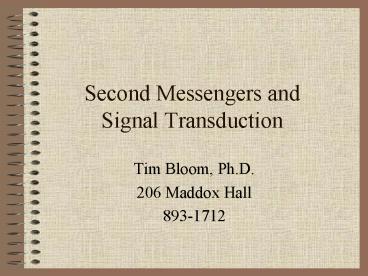Second Messengers and Signal Transduction - PowerPoint PPT Presentation
1 / 26
Title:
Second Messengers and Signal Transduction
Description:
... Review to Date Signal Transduction Signaling Examples Second Messengers Second Messengers Second Messengers Cyclic GMP cGMP Cyclic AMP cAMP cAMP System ... – PowerPoint PPT presentation
Number of Views:2642
Avg rating:3.0/5.0
Title: Second Messengers and Signal Transduction
1
Second Messengers and Signal Transduction
- Tim Bloom, Ph.D.
- 206 Maddox Hall
- 893-1712
2
Overview
- Signal transduction- a concept
- Second messengers
- Characteristics
- Examples
- Benefits
3
Review to Date
- Cells respond to specific molecules
- Generic name ligand
- Brand names acetylcholine, nicotine, insulin, etc
- Receptors recognize ligands
- Specific interaction based on shape and bonds
- Receptors respond to agonist ligands
- Response depends on specific nature of receptor
- Change in receptor activity is a signal
4
Signal Transduction
- Intracellular communication
- Detection of extracellular event
- Generation of internal change
- Bottom line- presence of external ligand causes a
change inside cell
5
Signaling Examples
- Ligands
- Estrogen
- Acetylcholine
- Insulin
- Epinephrine
- Receptors
- Transcription factor
- Sodium channel
- Receptor kinase
- G protein-coupled receptor
6
Second Messengers
- Molecules whose presence is a signal
- Synthesized or released from storage
- Act as intracellular ligands
- Commonly used in G protein-coupled receptor
signaling - Made or released by effector proteins
- (Ligand for GPCR is 1st messenger)
7
Second Messengers
- General characteristics
- Low amounts in resting state
- Regulated synthesis (or release)
- Regulated destruction (or removal)
- Act on intracellular proteins as agonists
8
Second Messengers
- Cyclic nucleotides
- cGMP
- cAMP
- Calcium
- Lipid derivatives
- IP3
- DAG
- Many others
9
Cyclic GMP
- Made from GTP
- Guanylate cyclase
- Membrane or soluble
- Acts as receptor
- Hydrolysis of cGMP to GMP terminates signal
10
cGMP
- Regulates several proteins as agonist
- Ion channel
- Protein kinase
- Important in smooth muscle relaxation
- Viagra interferes with cGMP hydrolysis
- Increases cGMP
- Prolongs cGMP signal
11
Cyclic AMP
- Made from ATP
- Adenylate cyclase
- Membrane only
- Not a receptor
- Hydrolysis of cAMP to AMP terminates signal
12
cAMP
- Regulates some ion channels as agonist
- Regulates a kinase
- Phosphorylates many substrates
- Substrate determines effect seen
- Increase glycogen breakdown
- Increase cardiac beat strength
- Etc.
13
cAMP System
- Example of typical second messenger set up
- Receptor
- G protein
- Effector protein
- Second messenger
- 2nd Messenger binding protein(s)
- Target(s) of SMBPs
14
cAMP Signaling Path
E
epinephrine
Gs
R
cAMP
ATP
15
cAMP Signaling Path
E
epinephrine
Gs
R
cAMP
ATP
PKA
16
cAMP Signaling Path
E
epinephrine
Gs
R
cAMP
ATP
PKA
Substrate-P
substrate
17
Calcium as a 2nd Messenger
- Low cytoplasmic Ca at rest
- Channels open with voltage and/or ligands
- Channels in PM and in calciosome
18
Calcium as a 2nd Messenger
- High cytoplasmic Ca when stimulated
- Pumps move calcium out of cytoplasm
- Pumps in PM and in calciosome
19
Calcium as a 2nd Messenger
- Many binding proteins mediate Ca action
- Activated by calcium
- Troponin C
- Calmodulin
- Calmodulin is multifunctional
20
Calmodulin Targets
- Cyclic AMP metabolism
- Adenylate cyclase (some versions)
- Phosphodiesterase (some versions)
- Protein phosphorylation
- Calmodulin-dependent kinases
- Calcineurin (a phosphatase)
- And others
21
Phospholipase C as Effector
- Inositol tri-phosphate
- Hydrophilic
- Agonist for internal calcium channel
- Cai rises
- Multiple effects through Ca-binding proteins
- Diacylglycerol (DAG)
- Hydrophobic
- Mimicked by phorbol esters (tumorogenic)
- Targets PKC (a kinase)
- PKC requires Ca and DAG
22
IP3/DAG Signaling Path
PKC
E
muscarine
G
R
Substrate-P
substrate
IP3 DAG
PI
Ca
calciosome
23
Why 2nd Messengers?
- Complicated pathways
- Difficult to understand
- Hard to learn
- Many parts makes easy to be disrupted
- Complexity allows flexibility
- More graded cellular responses
- Interaction of pathways
- Signal amplification
24
Signals and Effects
- Signal is required to produce cellular change
- Signal generated by receptor (or effector)
- Signal size related to of active receptors
- (dose response!)
25
Signal Amplification
- Example from G protein-coupled receptor
- Activated receptor hits several G proteins
- Each effector makes/ releases many molecules
- 2nd messenger receptor also amplifies, especially
if its a kinase - Bottom line one molecule of extracellular ligand
generates many modified proteins inside the cell
( a large signal)
26
Review
- Ligand binding alters receptor
- Some receptors use signaling molecules
- Synthesized from precursors
- Released from storage site
- Called second messengers
- Second messengers activate other proteins
- Activation acts as signal, changes things
- Second messenger is removed to end signal































